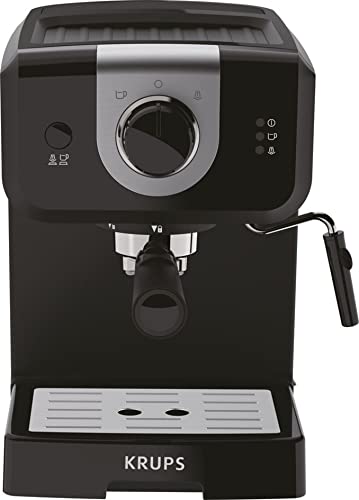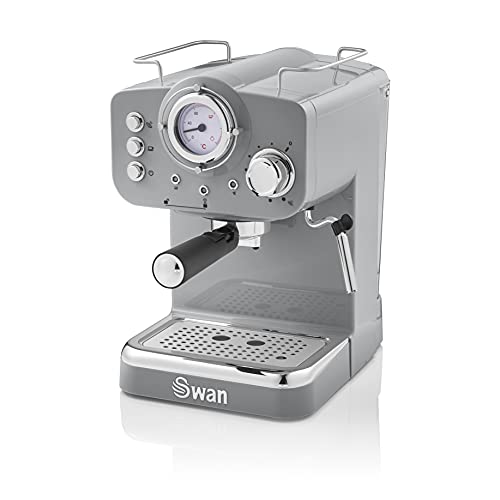Coffee Machines Espresso Techniques To Simplify Your Daily Life Coffee…
페이지 정보

본문
Coffee and Espresso Machines
Espresso machines make use of pressure to force water through finely ground and tamped coffee beans. They produce a rich and delicious cup of coffee.
Experts from the Good Housekeeping Institute recommend models that brew at the minimum pressure of 9 bars to get the best extraction. Beware of companies that claim to use higher pressure than what is required.
Types
The espresso maker (also known as a coffee and Espresso maker) brews coffee that is more concentrated, of better quality, and more expensive than the typical café drinks. It makes use of an average of nine bars of pressure. These machines are equipped with many options, such as temperature control and brew-strength control with programmable brewing as well as multiple sizes of drinks. They can also have steam wands for manual or automatic use to create an latte with a texturized milk. They are available in three primary kinds of espresso machines comprising semi-automatic, automatic and super-automatic models. Each espresso machine has its own degree and type of automation.
Semi-automatic espresso coffee machines for sale machines are the most popular for specialty coffee shops. Semi-automatic espresso machines permit baristas complete control over the brewing process, but aren't as user-friendly as fully automatic or automated machines. It is still necessary to grind beans, fill and tamp the portafilter and adjust the extraction time for the best quality espresso shot.
Automatic machines come with a built-in mill and measure and measure your grounds and. They automatically disperse the right amount of water to make the espresso, and they typically have a programmable drink size function. They were the most frequent espresso machine types in our lab tests, and they provide a good level of consistency as well as human control.
Functions
No matter if you opt for an engine driven machine or a steam-driven model, you'll get a reservoir that holds the water used to make your coffee. You'll have a heating component that will heat the water in order to create the pressure necessary to extract the coffee from the grounds.
When the button to brew is pressed when the button is pressed, the valve that lets water into the brew chamber is closed to ensure that only hot water with intense pressure can pass through the portafilter, and then into the ground coffee machines Espresso. It takes about 25 minutes for the water to brew into espresso.
The hot-water tubing, referred to as the insulated tubing, runs from the reservoir up to the spout at top of your machine. The resistance heating element warms the water while it goes through the warming plate made of steel and the aluminum tube.
After the spout has turned on and your cup is placed under the spout, so that the espresso flows into your drink through the portafilter. The coffee maker is also likely to have a steam wand, which you can use to heat and froth milk to make espresso-based drinks such as cappuccino or Latte.
Automated machines remove the guesswork involved in the process of brewing. They are easy to operate, programmable and are able to measure and grind beans and the tamping down process. They usually perform the best overall in our Lab tests, since they are easy to use and do not require much user expertise.
Materials
The inside of an espresso machine is a jungle of copper tubes, boilers made of stainless steel and sophisticated firmware. They might appear complicated but at the core they perform one simple thing: force hot water through finely ground coffee.
When buying an espresso machine coffee maker be sure to take into account the dimensions and space requirements, as along with drink options, energy saving options, and brewing precision. Look for a button that can be used to activate the steam wand. This is used to create latte arts and frothing milk. The front of the machine is equipped with an indicator of pressure that will show the operating pressure for the boiler and pump. You should look for the coffee maker that has two needles to see the pressures that are minimum and maximum.
If you're looking to create more than espresso, pick an decent espresso machine machine that can accommodate different sizes of brews, including the ristretto. There are models with an adjustable frothing hopper which allows for hassle-free, hands-free frothing. You can also switch between different kinds of milk easily. If you're experiencing hard water, choose the model that has a built-in water softener to prevent mineral buildup and keep your espresso machines for home tasting fresh.
Some manufacturers use a thermostat that is digital, integral and proportional to maintain an exact temperature range while brewing espresso. This feature guarantees a excellent cup of espresso every time. This feature also reduces energy costs because the machine only runs if needed.
Maintenance
As espresso machines and coffee makers are more widely available for home use, the proper maintenance of these machines becomes more important. The best equipment can make an enormous difference in the quality of your coffee but only if it's well maintained.
A regular maintenance and cleaning routine should include everything from cleaning the group head and steam wand to decaling, and finally changing the water filter on a regular basis. As a general rule for making between two and five cups of coffee a day, you should wash the majority of your machine at least once per week. Certain components of the machine will need to cleaned every two to three weeks, such as the water tank and grinder.
It is recommended to backflush the machine each week. This involves placing the portafilter in its place and running the brew cycles many times. This can help eliminate any coffee grounds or oils that have been left behind. You can also use a brush or cleaner made specifically for espresso machines to clean the portafilter.
 Maintaining your coffee and espresso machine correctly will also help it last longer. It is essential to maintain the expensive espresso machine.
Maintaining your coffee and espresso machine correctly will also help it last longer. It is essential to maintain the expensive espresso machine.
Espresso machines make use of pressure to force water through finely ground and tamped coffee beans. They produce a rich and delicious cup of coffee.
Experts from the Good Housekeeping Institute recommend models that brew at the minimum pressure of 9 bars to get the best extraction. Beware of companies that claim to use higher pressure than what is required.
Types
The espresso maker (also known as a coffee and Espresso maker) brews coffee that is more concentrated, of better quality, and more expensive than the typical café drinks. It makes use of an average of nine bars of pressure. These machines are equipped with many options, such as temperature control and brew-strength control with programmable brewing as well as multiple sizes of drinks. They can also have steam wands for manual or automatic use to create an latte with a texturized milk. They are available in three primary kinds of espresso machines comprising semi-automatic, automatic and super-automatic models. Each espresso machine has its own degree and type of automation.
Semi-automatic espresso coffee machines for sale machines are the most popular for specialty coffee shops. Semi-automatic espresso machines permit baristas complete control over the brewing process, but aren't as user-friendly as fully automatic or automated machines. It is still necessary to grind beans, fill and tamp the portafilter and adjust the extraction time for the best quality espresso shot.
Automatic machines come with a built-in mill and measure and measure your grounds and. They automatically disperse the right amount of water to make the espresso, and they typically have a programmable drink size function. They were the most frequent espresso machine types in our lab tests, and they provide a good level of consistency as well as human control.
Functions
No matter if you opt for an engine driven machine or a steam-driven model, you'll get a reservoir that holds the water used to make your coffee. You'll have a heating component that will heat the water in order to create the pressure necessary to extract the coffee from the grounds.
When the button to brew is pressed when the button is pressed, the valve that lets water into the brew chamber is closed to ensure that only hot water with intense pressure can pass through the portafilter, and then into the ground coffee machines Espresso. It takes about 25 minutes for the water to brew into espresso.
The hot-water tubing, referred to as the insulated tubing, runs from the reservoir up to the spout at top of your machine. The resistance heating element warms the water while it goes through the warming plate made of steel and the aluminum tube.
After the spout has turned on and your cup is placed under the spout, so that the espresso flows into your drink through the portafilter. The coffee maker is also likely to have a steam wand, which you can use to heat and froth milk to make espresso-based drinks such as cappuccino or Latte.
Automated machines remove the guesswork involved in the process of brewing. They are easy to operate, programmable and are able to measure and grind beans and the tamping down process. They usually perform the best overall in our Lab tests, since they are easy to use and do not require much user expertise.
Materials
The inside of an espresso machine is a jungle of copper tubes, boilers made of stainless steel and sophisticated firmware. They might appear complicated but at the core they perform one simple thing: force hot water through finely ground coffee.
When buying an espresso machine coffee maker be sure to take into account the dimensions and space requirements, as along with drink options, energy saving options, and brewing precision. Look for a button that can be used to activate the steam wand. This is used to create latte arts and frothing milk. The front of the machine is equipped with an indicator of pressure that will show the operating pressure for the boiler and pump. You should look for the coffee maker that has two needles to see the pressures that are minimum and maximum.
If you're looking to create more than espresso, pick an decent espresso machine machine that can accommodate different sizes of brews, including the ristretto. There are models with an adjustable frothing hopper which allows for hassle-free, hands-free frothing. You can also switch between different kinds of milk easily. If you're experiencing hard water, choose the model that has a built-in water softener to prevent mineral buildup and keep your espresso machines for home tasting fresh.
Some manufacturers use a thermostat that is digital, integral and proportional to maintain an exact temperature range while brewing espresso. This feature guarantees a excellent cup of espresso every time. This feature also reduces energy costs because the machine only runs if needed.
Maintenance
As espresso machines and coffee makers are more widely available for home use, the proper maintenance of these machines becomes more important. The best equipment can make an enormous difference in the quality of your coffee but only if it's well maintained.
A regular maintenance and cleaning routine should include everything from cleaning the group head and steam wand to decaling, and finally changing the water filter on a regular basis. As a general rule for making between two and five cups of coffee a day, you should wash the majority of your machine at least once per week. Certain components of the machine will need to cleaned every two to three weeks, such as the water tank and grinder.
It is recommended to backflush the machine each week. This involves placing the portafilter in its place and running the brew cycles many times. This can help eliminate any coffee grounds or oils that have been left behind. You can also use a brush or cleaner made specifically for espresso machines to clean the portafilter.
 Maintaining your coffee and espresso machine correctly will also help it last longer. It is essential to maintain the expensive espresso machine.
Maintaining your coffee and espresso machine correctly will also help it last longer. It is essential to maintain the expensive espresso machine.
- 이전글Coffee Machine For Home It's Not As Hard As You Think 24.12.04
- 다음글The 10 Most Dismal Double Stroller Errors Of All Time Could Have Been Prevented 24.12.04
댓글목록
등록된 댓글이 없습니다.


 한국어
한국어  plastic surgery center
plastic surgery center





